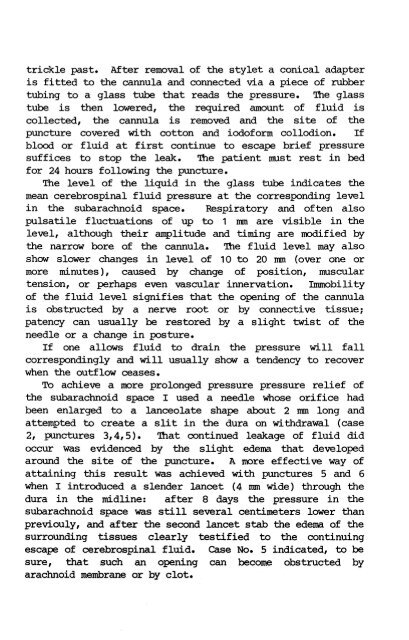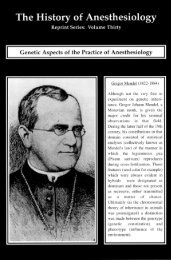Download PDF - Wood Library-Museum of Anesthesiology
Download PDF - Wood Library-Museum of Anesthesiology
Download PDF - Wood Library-Museum of Anesthesiology
You also want an ePaper? Increase the reach of your titles
YUMPU automatically turns print PDFs into web optimized ePapers that Google loves.
trickle past. After removal <strong>of</strong> the stylet a conical adapteris fitted to the cannula and connected via a piece <strong>of</strong> rubbertubing to a glass tube that reads the pressure. The glasstube is then lowered, the required amount <strong>of</strong> fluid iscollected, the cannula is removed and the site <strong>of</strong> thepuncture covered with cotton and iod<strong>of</strong>orm collodion. Ifblood or fluid at first continue to escape brief pressuresuffices to stop the leak. The patient must rest in bedfor 24 hours following the puncture.The level <strong>of</strong> the liquid in the glass tube indicates themean cerebrospinal fluid pressure at the corresponding levelin the subarachnoid space. Respiratory and <strong>of</strong>ten alsopulsatile fluctuations <strong>of</strong> up to 1 mm are visible in thelevel, although their amplitude and timing are modified bythe narrow bore <strong>of</strong> the cannula. The fluid level may alsoshow slower changes in level <strong>of</strong> 10 to 20 mm (over one ormore minutes), caused by change <strong>of</strong> position, musculartension, or perhaps even vascular innervation. Immobility<strong>of</strong> the fluid level signifies that the opening <strong>of</strong> the cannulais obstructed by a nerve root or by connective tissue;patency can usually be restored by a slight twist <strong>of</strong> theneedle or a change in posture.If one allows fluid to drain the pressure will fallcorrespondingly and will usually show a tendency to recoverwhen the outflow ceases.To achieve a more prolonged pressure pressure relief <strong>of</strong>the subarachnoid space I used a needle whose orifice hadbeen enlarged to a lanceolate shape about 2 mm long andattempted to create a slit in the dura on withdrawal (case2, punctures 3,4,5), That continued leakage <strong>of</strong> fluid didoccur was evidenced by the slight edema that developedaround the site <strong>of</strong> the puncture. A more effective way <strong>of</strong>attaining this result was achieved with punctures 5 and 6when I introduced a slender lancet (4 mm wide) through thedura in the midline: after 8 days the pressure in thesubarachnoid space was still several centimeters lower thanpreviouly, and after the second lancet stab the edema <strong>of</strong> thesurrounding tissues clearly testified to the continuingescape <strong>of</strong> cerebrospinal fluid. Case No. 5 indicated, to besure, that such an opening can become obstructed byarachnoid membrane or by clot.
















